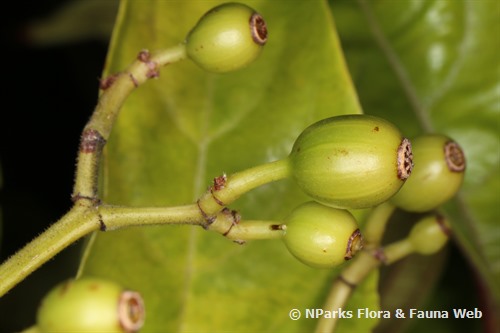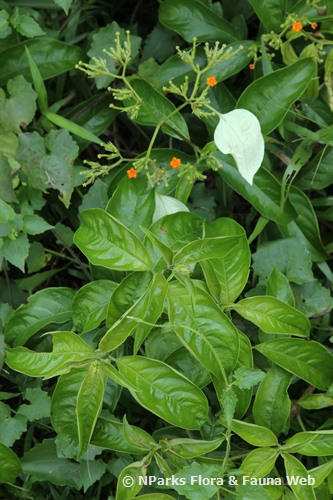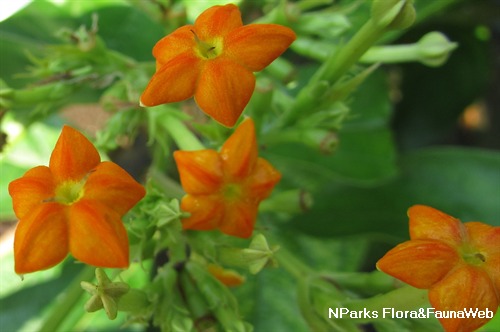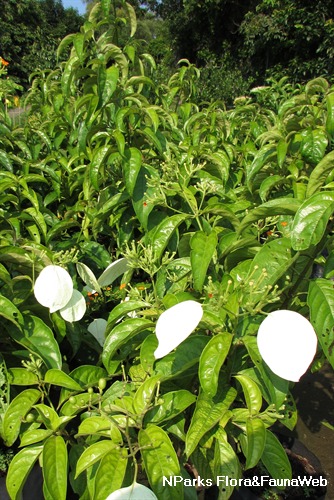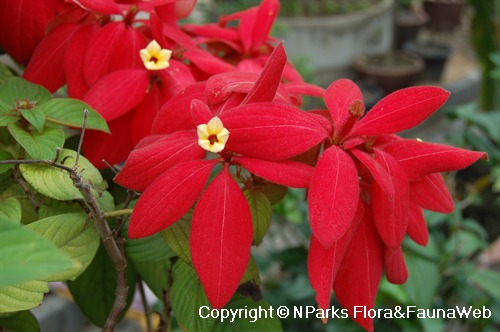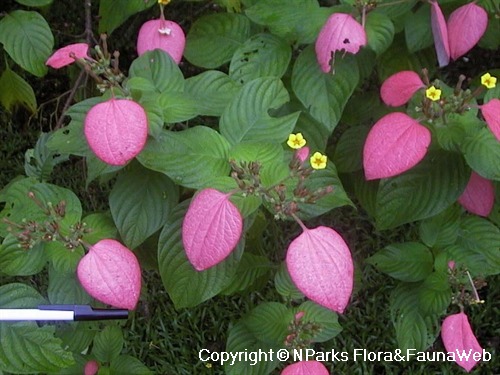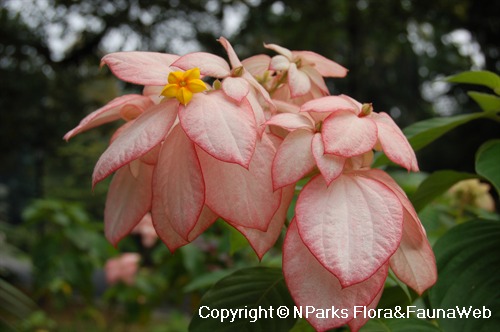
Back
Mussaenda glabra Vahl
| Family Name: | Rubiaceae |
| Common Name: | Adap-Adap, Balik Adap, Belak Adap, Cha Pedi, Daun Puteri, Segoreh, 光叶玉叶金花 |
Name
Classifications and Characteristics
| Plant Division | Angiosperms (Flowering Seed Plants) (Dicotyledon) |
|---|---|
| Plant Growth Form | Shrub |
| Lifespan (in Singapore) | Perennial |
| Plant Shape | Shrubby |
| Maximum Height | 1 m |
Biogeography
| Native Distribution | Peninsular Malaysia and Singapore |
|---|---|
| Native Habitat | Terrestrial (Secondary Rainforest, Freshwater Swamp Forest, Disturbed Area / Open Ground) |
| Preferred Climate Zone | Tropical |
| Local Conservation Status | Native to Singapore (Endangered (EN)) |
Description and Ethnobotany
| Growth Form | It is a climbing bush reaching up to 1 m height, and has hairless, lenticellate branches. |
|---|---|
| Foliage | Its opposite , stalked leaves have leathery blades that are usually oblong to lance-shaped with a pointed tip, bright green above, green below, 6.4–8.9 by 1.3–4 cm, and have 5–6 pairs of veins that are hairless or covered with soft hair. |
| Flowers | Its flowers are orange-red, covered with soft hair that are yellow at the mouth, and arranged in clusters at the end of flowering branches. |
| Fruit | Its fruit is oblong, green, 1.3 cm long, and has tiny seeds. |
| Habitat | It grows in open habitats. |
| Associated Fauna | Its flowers are insect-pollinated. |
| Cultivation | It can be propagated by seed and stem cutting. |
| Etymology | Latin Mussaenda, from the Singhalese vernacular name for Mussaenda frondosa; Latin glabra, not covered with hair, possibly referring to the stem of this climber |
| Ethnobotanical Uses | Edible Plant Parts : Edible Leaves Food (Fruit or Vegetable) (Herb or Spice) Medicinal: Its leaves can be used to make tea which may be given for cough. The leaves are chewed with betel, consumed to treat bowel complaints, as a poultice for headache, or eaten in salad. A decoction of the roots is given after childbirth. |
Landscaping Features
| Landscaping | It is suitable for parks as a sprawling shrub if grown without a trellis. |
|---|---|
| Desirable Plant Features | Ornamental Flowers |
| Landscape Uses | Parks & Gardens, Small Gardens, Trellis / Arbour / Pergola, Flowerbed / Border |
Fauna, Pollination and Dispersal
| Fauna Pollination Dispersal Associated Fauna | Butterfly-Attracting |
|---|---|
| Pollination Method(s) | Biotic (Fauna) |
| Seed or Spore Dispersal | Biotic (Fauna) |
Plant Care and Propagation
| Light Preference | Full Sun |
|---|---|
| Water Preference | Moderate Water |
| Plant Growth Rate | Moderate |
| Rootzone Tolerance | Moist Soils, Well-Drained Soils, Fertile Loamy Soils |
| Propagation Method | Seed, Stem Cutting |
Foliar
| Foliage Retention | Evergreen |
|---|---|
| Mature Foliage Colour(s) | Green |
| Mature Foliage Texture(s) | Velvety / Furry / Tomentose, Leathery |
| Foliar Modification | Stipule |
| Foliar Type | Simple / Unifoliate |
| Foliar Arrangement Along Stem | Opposite |
| Foliar Attachment to Stem | Petiolate |
| Foliar Shape(s) | Non-Palm Foliage (Lanceolate, Oblong) |
| Foliar Venation | Pinnate / Net |
| Foliar Margin | Entire |
Floral (Angiosperm)
| Flower & Plant Sexuality | Bisexual Flowers |
| Flower Colour(s) | Orange, Yellow / Golden |
|---|---|
| Flower Grouping | Cluster / Inflorescence |
| Flower Location | Terminal |
| Flower Symmetry | Radial |
Fruit, Seed and Spore
| Mature Fruit Colour(s) | Green |
|---|---|
| Fruit Classification | Simple Fruit |
| Fruit Type | Fleshy Fruit , Non-Accessory Fruit |
Image Repository
Others
| Master ID | 30146 |
|---|---|
| Species ID | 4455 |
| Flora Disclaimer | The information in this website has been compiled from reliable sources, such as reference works on medicinal plants. It is not a substitute for medical advice or treatment and NParks does not purport to provide any medical advice. Readers should always consult his/her physician before using or consuming a plant for medicinal purposes. |


